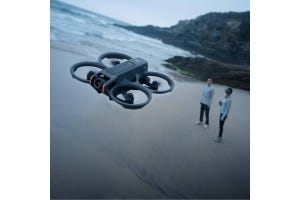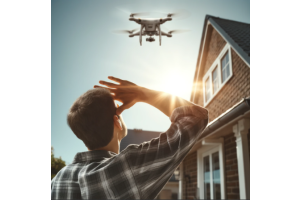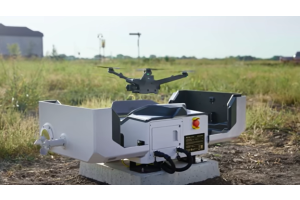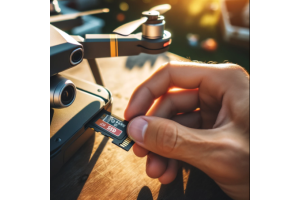Drones have completely transformed the way we view the world, quite literally. With companies like DJI leading the charge, aerial photography and data collection have never been more detailed or efficient. The recent launch of DJI’s Zenmuse L2 is a testament to that, especially with its advanced imagery features – and GIS professionals are particularly set to benefit.
With geospatial data collection, you often grapple with challenges like insufficient resolution, time-consuming data processing, and operational inefficiencies. While GIS mapping drones have undeniably sped up operations, the demand for precise, quick, and cost-effective solutions remains - and the payload plays a huge role.
What Makes Zenmuse L2 Stand Out?
The Zenmuse L2 is quite the packed drone payload for professionals across various sectors, from land surveyors to electricity inspectors.


It's crown jewel, the 4/3 CMOS RGB camera has piqued our interest here especially with drones for geospatial imaging – let’s dig into it.
A Glimpse into the RGB Mapping Camera
With a mechanical shutter and an enlarged pixel size of 3.3 μm, the camera ensures crisp images. The effective pixels have reached a staggering 20 MP, providing a significant improvement in overall imaging. That way a land surveyor working on a new highway project can capture high-definition images of the terrain, identifying potential obstacles or points of interest with superior clarity. From city planners tasked with redeveloping old neighborhoods to conservationists tracking erosion on a coastal line need accurate data, the L2's RGB camera provides the imagery for the task.
Benefits in Geospatial Data Collection
With the ability to take photos at a reduced interval of 0.7 seconds, GIS professionals can capture more in less time. The camera's shutter count of up to 200,000 times further reduces operational costs. And if you aren’t in the mood for point cloud collection, fret not. The RGB camera can still snap photos, record videos, or collect images for visible light mapping. And speaking of which, in just a single drone flight, you can use the L2 to capture data over 2.5km2 area range.
Working Hand-In-Hand with LiDAR
The Zenmuse L2 isn’t just about its camera. It comes with LiDAR technology, giving professionals an edge when it comes to data collection, especially when working with drones like the DJI Matrice 300 RTK or Matrice 350 RTK for your GIS mapping. The RGB mapping camera enriches the colorized point cloud details, making it easier to interpret and analyze the data. This capacity actually surpasses the L1. In fact, let’s look briefly at more of that:
The Zenmuse L2 vs. L1: The Evolution
With L2, there's a 30% increase in detection range, allowing objects to be detected from a distance of 250 meters at 10% reflectivity. This is a significant leap compared to L1.
Furthermore, L2's operational altitude extends up to 150 meters, enhancing safety and efficiency. The spot size has also been reduced to just 4x12 cm at 100m, which is merely a fifth of L1's. This tighter focus enables the L2 to detect smaller objects with far more detail.
The combination of the camera and LiDAR means that not only can you get high-definition images, but you also obtain accurate, reliable 3D data acquisition. This duo ensures that while you're capturing detailed images, you’re also collecting valuable data, be it for mapping or inspections.
Zenmuse L2 and DJI Terra: An Unbeatable Combo
The beauty of L2 lies not just in its advanced hardware but in its compatibility with software solutions like DJI Terra. With this particular pairing, the Zenmuse L2 delivers a ready-to-go solution for 3D data collection and post-processing. So, after you've captured the data, processing becomes a breeze. Talk about efficiency!
DJI's introduction of an in-house IMU system for the Zenmuse L2 emphasizes its commitment to accuracy. With a remarkable vertical accuracy of 4cm and a horizontal one of 5cm, it effortlessly meets the 1:500 high-precision terrain surveying standards.
And with instant activation, professionals won’t have to keep waiting. The moment Zenmuse L2 powers on, it's all systems go. DJI has ensured the IMU system of the Zenmuse L2 is robust and adaptable to varying environmental conditions, enhancing both its reliability and precision.
DJI Terra's Latest Update: Tailored for Zenmuse L2
With version 3.9.0 of DJI Terra now available for download, a slew of enhancements and support features have been introduced:
What's New:
- Zenmuse L2 Integration: The software can now process data gathered by the Zenmuse L2.
- PPK Calculation: An exclusive feature for data collected by Zenmuse L2 in mainland China.
- LiDAR Calibration: DJI Terra has expanded its calibration feature to support both Zenmuse L1 and the new L2.
- Altitude Control and Check: An option to import altitude control points for LiDAR point cloud reconstruction missions. A refined accuracy control and check feature have been introduced.
- Third-Party Software Support: The latest version supports exporting XML files, which can then be integrated into third-party software for enhanced 2D/3D reconstruction.
- Enhanced Reports: The DJI Terra Quality Report for LiDAR Point Cloud Processing has been revamped to provide more detailed parameters, including IMU Trajectory Error and Check Point RMSE.
Tweaks and Improvements:
Optimized Point Cloud Processing: The software now ensures a more streamlined point cloud with approximately 1/3 of the previous version’s density when the Smooth Point Cloud function is activated.
Fixes to Ensure Smoother Operations:
Resolved issues related to multi-camera or varied resolution image data processing.
Addressed a glitch where the annotation and measurement functionality became inaccessible for LiDAR point cloud reconstruction tasks on the previous DJI Terra version.
Real-time Monitoring and Analysis
Using the DJI Pilot 2 software, professionals can monitor their operations in real-time. They can switch between RGB and point cloud displays, or even view them side by side. It’s about having control over the operation and ensuring that you capture all the necessary data without missing a beat.
Practical Applications Across Other Industries
Say you’re forestry professional aiming to understand the growth of a forest patch over time. With L2's advanced RGB mapping camera, you can penetrate through canopies, identifying variations in tree height and crown width. This helps in making informed decisions about forest conservation and logging.
For electricity inspectors, the challenges of using photogrammetry methods for reconstructing lines and components are long-standing. With L2, collecting point cloud data becomes efficient. They can quickly identify potential risks, measure distances between vegetation and powerlines, and plan inspections based on accurate data.
DJI's Zenmuse L2 with its advanced RGB mapping camera is a step into the future of aerial geospatial data collection. It assures professionals of quality, efficiency, and reliability. So, if you’re in the world of geospatial data collection, it's time to consider the Zenmuse L2. Because, with it, you’ll certainly capture more and process less.





